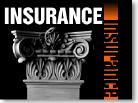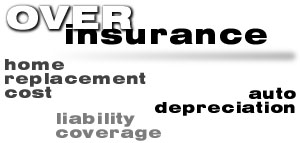|
The pitfalls of overinsuring
|
 |
May 13, 1999: 10:43 a.m. ET
Poor insurance planning can mean you're paying for too much coverage
|
NEW YORK (CNNfn) - Inattentive planning or simply concern about making sure all the important parts of your life are covered by insurance can lead you into the pitfalls of being overinsured.
And while overinsurance can be the safest way to go, you'll pay a heavy price for it, spending money unnecessarily when it could be put to better use.
Americans are more likely to make the mistake of having too little insurance, but the number who have too much isn't insignificant.
According to the Insurance Information Institute, 35 percent of U.S. homeowners are underinsured while 17 percent are overinsured in some way.
Americans are faced with a dazzling array of insurance options and requirements, everything from homeowner's policies to auto insurance to life and health coverage.
When you combine that with insurance agents who may or may not know what's best for the insured, you may end up with coverage that's less than a perfect fit.
Insuring your home
Homes are often the largest purchases anyone makes in their lifetime, so owners may feel justified in making sure they have rock solid coverage from top to bottom.
While wanting to make sure all the bases are covered is a sound idea, some homeowners don't make the necessary adjustments to assure they are paying only for what they need.
The general rule of thumb for homeowners is to insure their homes for 100 percent of the rebuilding cost, or at the very least, 80 percent.
However, if you don't stay on top of housing trends, your insurance may be above what you need, according to Jayna Neagle, manager of new media at the Insurance Information Institute.
"You want to insure that if [your home] is completely destroyed, you can replace it," said Neagle. "That means looking at building costs, and these building costs go up and down."
Therefore, if building costs go down in your area, you could be essentially paying premiums for coverage that would more than pay for your replacement costs.

To find out how much you would need to replace your house, talk to the local building association, a real estate agent or even local construction companies to see how much they charge.
It's not an exact science since the style and complexities of houses vary, but they should be able to give you the building cost per square foot.
After you know that figure, multiply it by the square footage of your current home. If local building costs are $90 per square foot and your home is 2,200 square feet, your general replacement cost estimate would be $198,000.
Don't fall into the trap of insuring your home for its market value, since the replacement cost may be higher or lower than that.
Home insurance policies should be reviewed every year when you renew them to make sure you don't overinsure or leave any gaps.
Some insurance policies do the work for you to make sure you don't carry too much coverage.
One such policy is a guaranteed replacement cost policy. This type will pay the full cost of replacing your home structure without you having to pay a deduction for depreciation and it has no dollar limit. This insurance isn't available in all states, however.
Easier still might be putting an inflation guard clause in your policy. This will automatically adjust your policy each time you renew so that if the building costs in your area decrease, so will the coverage, while increasing coverage if those costs rise.
High revving auto insurance
Overinsurance dangers can lurk in the garage as well if you don't adjust your automobile insurance adequately.
Unlike your home, automobiles are almost guaranteed to depreciate, yet many people maintain the high coverage they had when the car was new, even though now the car may be rusty and dinged, with high mileage.
Keep an eye on the Kelley Blue Book value of your automobile from year to year, a good gauge of what to insure your car for, since you will rarely get anything more than the Blue Book estimate.
Check your car's Blue Book value online
After your car reaches a certain point, you may want to consider lowering or dropping some of your insurance.
"Normally, $4,000 is the threshold at which you can drop collision and comprehensive," said Insurance Information Institute's Neagle, who explained that once the deductible is taken away, you can be paying close to your car's Blue Book value in premiums each year.
Having too high a deductible can be another way of overinsuring, according to certified financial planner Mari Adam of Adam Financial Associates Inc. in Fort Lauderdale, Fla.
"Some people have deductibles for $100 and $200," said Adam.
"It's really not to your advantage to insure for such small amounts because if you file a claim for those low amounts, it will raise your premiums much more than that."
The right combination
Since homeowners usually have so many types of insurance it may make sense -- both organizationally and financially -- to combine some of them and eliminate a little waste and overlap.
One way to do this is with an umbrella liability policy, according to Dave Bergmann, a certified financial planner and head of the Marina Del Ray, Calif.-based David R. Bergmann Group.
Many people have liability coverage for both their home and automobiles to protect against damages and injury claims.
An umbrella liability policy would act as an overarching policy, covering and supplementing those types of coverage in one policy.
"If you have all your policies under one roof, you may be able to lower the base policy and premiums," said Bergmann.
Finally, people should make sure they aren't jacking up their life insurance coverage to more than is necessary to the detriment of their current finances.
Bergmann explained that while life insurance is obviously an important part of financial planning, overextending your coverage to more than your survivors would reasonably need could prevent you from investing the additional money in the present and getting a better return.
Being overinsured is better than underinsured, but if you evaluate your coverage each year to allow for changes in your life, you can make sure you are paying for just the right amount of insurance. 
-- by staff writer Randall J. Schultz
|
|
|
|
|
 |

|

